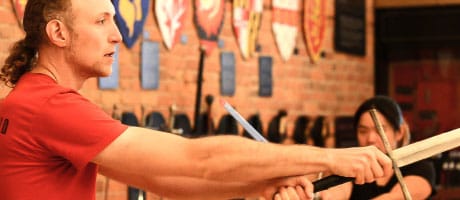What You’ll Learn
- the history of the longsword
- an orientation to this video course series (Fundamentals I-II-III)
- the tenets of our study: why we practice the way we do
- holding and maneuvering the sword
- making the six cuts of the sword, and cutting patterns to practice on your own
- the names of the core postures (about a dozen or so) in the Italian system
Practitioners of other longsword systems (German or Spanish, for instance) will see many mechanical similarities, even though the terminology may be different.
Each topic contains a short video, retention quiz, practice notes and discussion.
What You’ll Need
- A sword specifically made for practice, preferably one constructed, weighted and balanced to match the sword being studied.
- If you don’t have a sword, a wooden dowel or other staff (36–42 inches for rapier/sidesword, 40–50 inches for longsword).
- Gloves can make handling some swords more comfortable and prevent abraisions.
- A mirror, video camera, or partner to help check your form and provide feedback.
Get the Certificate
If you have completed all three Fundamentals sub-courses (I, II and III), you are eligible for the completion certificate. Click here to go the confirmation page and get your printable certificate of completion for Longsword Fundamentals.
Acknowledgement of Safety and Risk
- Practice all exercises slowly and with control.
- Practice using training swords that are not sharp and are specifically made for practice.
- Use protective gear for all exercises. In many of our videos we are not wearing head, throat or body protection in order to make clear explanation more possible. You should always use protective gear when practicing these arts regardless of the exercise.
- Be aware that injuries in training are always possible. Ensure that you are practicing with care and caution at all times.
- DuelloTV is not responsible for any injuries that occur as a result of sword practice inspired from our videos.
Course Content
About Instructor
Login
Accessing this course requires a login. Please enter your credentials below!
